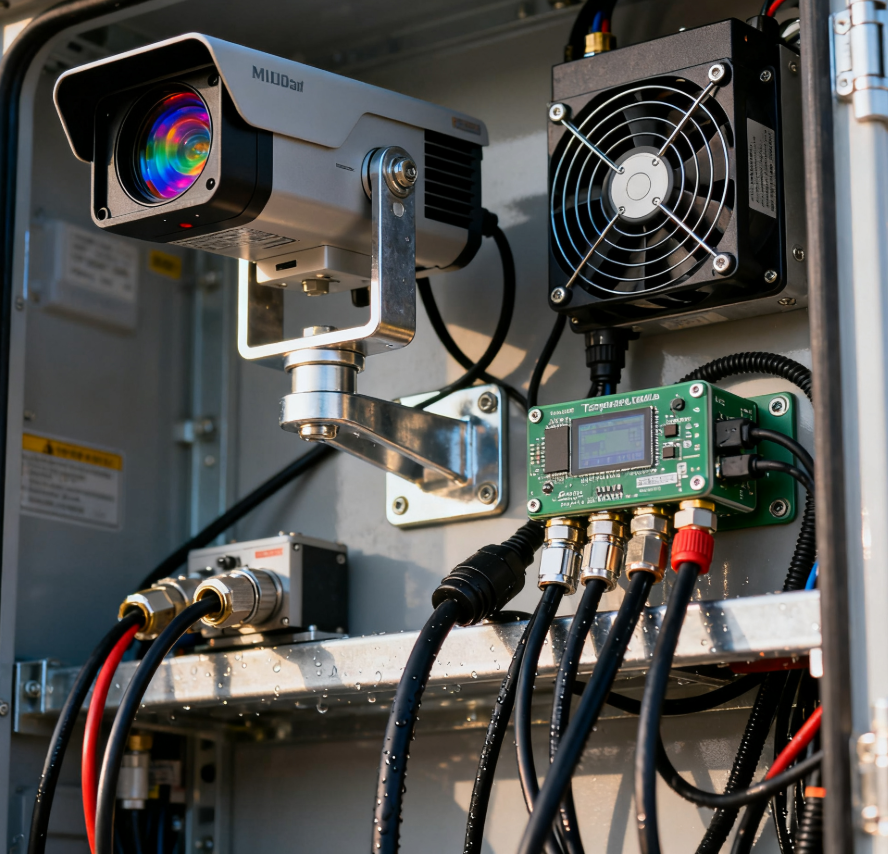Introduction
In modern industrial, transportation, and IoT applications, integrating mmWave radar sensors with thermal cameras has become common practice. These systems provide precise motion detection, temperature monitoring, and enhanced situational awareness. However, even highly reliable devices can experience operational issues if thermal loads, electrical compatibility, or environmental factors are not carefully managed.
Unexpected failures—such as frozen images or complete device shutdowns—can lead to delays, increased maintenance costs, and operational inefficiencies. Understanding how to mitigate these risks is essential for technical teams, procurement managers, and decision-makers. This guide focuses on practical strategies to ensure stable, reliable integration while maintaining long-term equipment performance.
Common Integration Challenges
1. Heat Generation
Even low-power mmWave radar modules generate heat during continuous operation. When positioned near thermal cameras, this heat can temporarily or permanently degrade performance. Prolonged exposure may trigger sensor malfunction or reduce the lifespan of sensitive electronics.
2. Host Device Compatibility
Modern smartphones, embedded systems, or microcontrollers may vary in voltage and current delivery. Differences in USB power, signal timing, or grounding can affect peripheral stability. Testing across multiple platforms is necessary to prevent unexpected failures.
3. Electromagnetic Interference
High-frequency radar signals can induce minor interference in nearby electronics. While usually minimal, in sensitive setups this can affect image quality or cause sporadic glitches. Shielding and careful placement significantly reduce this risk.
Practical Integration Strategies
Thermal Management
Effective thermal management ensures reliable performance:
-
Physical Separation: Keep adequate distance between radar modules and thermal cameras to prevent direct heat transfer.
-
Cooling Solutions: Use heat sinks, fans, or passive ventilation for continuous operation in enclosed environments.
-
Temperature Monitoring: Implement real-time monitoring with software or dedicated sensors to track operating temperatures and detect anomalies early.
Power and Compatibility Checks
Device stability depends on proper power delivery and host compatibility:
-
Verify voltage and current specifications for all connected devices.
-
Conduct incremental testing across multiple host platforms.
-
Isolate high-power devices to prevent overloading shared circuits.
Safe Placement and Shielding
To reduce interference and protect sensitive electronics:
-
Use shielded cables to minimize electromagnetic coupling.
-
Maintain clear separation between radar modules, cameras, and other electronics.
-
Position devices on separate mounting frames when possible.
Documentation and Risk Management
Documenting setup, configuration, and test outcomes is crucial:
-
Keep detailed logs of device configurations and operational parameters.
-
Record thermal readings and environmental conditions during testing.
-
Maintain backup equipment to minimize downtime in critical operations.
Linpowave Practices
Linpowave has deployed mmWave radar modules alongside thermal cameras in multiple projects. Best practices include:
-
Separate mounting frames to prevent heat accumulation.
-
Dedicated power lines for each module to ensure stable operation.
-
Real-time temperature monitoring of adjacent electronics.
-
Incremental testing cycles to mitigate overheating during integration.
These measures help maintain reliable operation, reduce maintenance costs, and optimize long-term system performance.
Recommendations for Decision-Makers
-
Procurement Planning: Allocate resources for thermal management and host device testing to prevent costly failures.
-
Operational Reliability: Enforce documented integration protocols to maintain consistent system performance.
-
Technical Oversight: Ensure teams follow stepwise testing, temperature monitoring, and safe placement practices.
-
Cost Efficiency: Early mitigation of heat and compatibility issues reduces long-term maintenance and replacement costs.
FAQ
Q1: Can mmWave radar affect thermal camera performance?
A: Indirect effects such as heat accumulation or electromagnetic interference can affect stability. Proper separation and cooling solutions minimize these risks.
Q2: Should new host devices be tested differently?
A: Yes. Variations in power delivery or signal timing can affect stability. Test all host devices before deployment.
Q3: How can overheating be managed in multi-device setups?
A: Maintain spacing, implement heat sinks or fans, monitor temperatures in real time, and limit continuous operation during testing.
Q4: Are there long-term risks from mmWave radar integration?
A: Properly powered and spaced radar modules are generally safe. Documented integration protocols further reduce long-term risk.
Q5: What is the best approach if a device fails during testing?
A: Disconnect devices, document the setup, and contact technical support or vendor guidance immediately.
Learn More About Linpowave Radar Solutions
For teams integrating mmWave radar sensors, Linpowave offers short- and medium-range radar modules designed for precise detection, low power consumption, and easy integration with thermal cameras and other electronics.
Whether your project involves smart transportation, industrial automation, or IoT applications, Linpowave solutions provide reliable performance, flexible interfaces, and proven operational stability.
👉 Explore our product portfolio and integration guides on the Linpowave website to see how our radar modules can support your next project with minimal setup time and maximum reliability.
Conclusion
Integrating mmWave radar with thermal cameras requires attention to thermal management, device compatibility, and safe placement practices. Following these guidelines protects sensitive equipment, ensures stable operation, and reduces long-term maintenance costs.
By implementing these strategies, teams and decision-makers can confidently deploy mmWave radar systems alongside sensitive electronics, achieving reliable performance and operational efficiency in industrial, transportation, and IoT projects.



